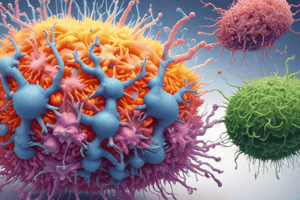Podcast
Questions and Answers
Which of the following is NOT a characteristic of viruses?
Which of the following is NOT a characteristic of viruses?
- They consist of nucleic acid surrounded by a protein coat.
- They are noncellular.
- They can infect both plants and animals.
- They can be seen with a light microscope. (correct)
Which of the following organisms is classified as a prokaryote?
Which of the following organisms is classified as a prokaryote?
- Protozoa
- Algae
- Bacteria (correct)
- Fungi
What is the function of ribosomes in a cell?
What is the function of ribosomes in a cell?
- Lipid synthesis
- Protein synthesis (correct)
- Packaging and shipping of proteins
- Cellular respiration
Which of the following is a key difference between smooth endoplasmic reticulum (SER) and rough endoplasmic reticulum (RER)?
Which of the following is a key difference between smooth endoplasmic reticulum (SER) and rough endoplasmic reticulum (RER)?
What is the function of lysosomes within a cell?
What is the function of lysosomes within a cell?
Which of the following statements accurately describes the relationship between bacteria and spores?
Which of the following statements accurately describes the relationship between bacteria and spores?
Which of the following is a true statement about prions?
Which of the following is a true statement about prions?
Which of these is NOT a eukaryotic organism?
Which of these is NOT a eukaryotic organism?
What is the primary function of the Golgi apparatus?
What is the primary function of the Golgi apparatus?
Which of the following is NOT a characteristic of Archaea?
Which of the following is NOT a characteristic of Archaea?
Flashcards
Taxonomy
Taxonomy
The formal system of organizing, classifying, and naming living organisms.
Bacteria
Bacteria
Prokaryotic, unicellular organisms that can cause infections.
Archaea
Archaea
Prokaryotic, unicellular organisms that thrive in extreme environments.
Viruses
Viruses
Signup and view all the flashcards
Fungi
Fungi
Signup and view all the flashcards
Endospores
Endospores
Signup and view all the flashcards
Mitochondria
Mitochondria
Signup and view all the flashcards
Golgi Apparatus
Golgi Apparatus
Signup and view all the flashcards
Ribosomes
Ribosomes
Signup and view all the flashcards
Lysosomes
Lysosomes
Signup and view all the flashcards
Study Notes
Taxonomy of Living Organisms
- Taxonomy is a formal system for organizing, classifying, and naming living organisms.
- Bacteria: Prokaryotic, single-celled organisms.
- Archaea: Prokaryotic, single-celled organisms, thriving in extreme environments (high salt, high temperature).
- Algae: Eukaryotic organisms that perform photosynthesis.
- Fungi: Eukaryotic organisms, either single-celled or multicellular.
- Protozoa: Eukaryotic, single-celled or multicellular organisms.
- Viruses: Non-cellular agents, only visible with electron microscopes, consisting of nucleic acid surrounded by a protein coat.
- Viroids: Non-cellular plant pathogens, RNA-based, unable to produce proteins or have a protein coat.
- Virusoids: Non-cellular plant pathogens primarily, RNA-based. One type (HDV) infects humans.
- Prions: Non-cellular, misfolded normal animal proteins, infectious (lack nucleic acid).
Bacterial Life Cycle
- Bacteria exist in a vegetative form, actively metabolizing, growing, and multiplying.
- Under unfavorable conditions, some vegetative cells convert to spores (endospores) through sporulation.
- Spores are dormant, resistant structures that can survive for years.
- Spores revert to their vegetative form (germinates) when environmental conditions improve.
Cytoplasmic Organelles
- Mitochondria: Fluid-filled sacs, responsible for ATP production (energy).
- Ribosomes: Small RNA granules, either free in the cytoplasm or attached to the endoplasmic reticulum, essential for protein synthesis.
- Endoplasmic Reticulum (ER): Network of membranes.
- Smooth ER: Involved in lipid synthesis.
- Rough ER: Involved in protein synthesis and transportation.
- Golgi Apparatus: Flat sacs connected to ER, processing and packaging proteins.
- Lysosomes: Sacs containing enzymes that break down particles (e.g., bacteria).
- Centrioles: Two rods at right angles, crucial for cell division.
- Cilia: Short, numerous hair-like projections that move substances across cell surfaces (e.g., respiratory tract).
- Flagella: Long, few structures that enable cell movement.
- Chloroplasts: Found in algae and plant cells, converting sunlight into chemical energy (photosynthesis).
Defense Mechanisms Against Infection
- Nonspecific mechanisms: Provide general resistance against all harmful agents.
- Specific mechanisms: Provide immunity, aimed at specific harmful agents.
- Susceptibility: Lack of resistance.
- Virulence: The degree of pathogenicity or disease-causing potential of a microbe.
Studying That Suits You
Use AI to generate personalized quizzes and flashcards to suit your learning preferences.




